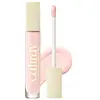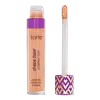What's inside
What's inside
 Key Ingredients
Key Ingredients

 Benefits
Benefits

 Concerns
Concerns

 Ingredients Side-by-side
Ingredients Side-by-side

Water
Skin ConditioningCaprylyl Methicone
Skin ConditioningIsododecane
EmollientDicaprylyl Carbonate
EmollientCetyl PEG/PPG-10/1 Dimethicone
EmulsifyingPropanediol
Solvent1,2-Hexanediol
Skin ConditioningSilica Dimethyl Silylate
EmollientSodium Chloride
MaskingTrimethylsiloxysilicate
EmollientSynthetic Fluorphlogopite
Glycerin
HumectantPEG-30 Dipolyhydroxystearate
EmulsifyingSilica
AbrasiveTriethoxycaprylylsilane
Phenoxyethanol
PreservativeDisteardimonium Hectorite
StabilisingSodium Hyaluronate
HumectantPropylene Carbonate
SolventCaffeine
Skin ConditioningTin Oxide
AbrasiveTocopherol
AntioxidantAcetyl Tetrapeptide-5
HumectantCI 77891
Cosmetic ColorantIron Oxides
Water, Caprylyl Methicone, Isododecane, Dicaprylyl Carbonate, Cetyl PEG/PPG-10/1 Dimethicone, Propanediol, 1,2-Hexanediol, Silica Dimethyl Silylate, Sodium Chloride, Trimethylsiloxysilicate, Synthetic Fluorphlogopite, Glycerin, PEG-30 Dipolyhydroxystearate, Silica, Triethoxycaprylylsilane, Phenoxyethanol, Disteardimonium Hectorite, Sodium Hyaluronate, Propylene Carbonate, Caffeine, Tin Oxide, Tocopherol, Acetyl Tetrapeptide-5, CI 77891, Iron Oxides
Water
Skin ConditioningDimethicone
EmollientPropanediol
SolventTrimethylsiloxysilicate
EmollientIsododecane
EmollientGlycerin
HumectantCetyl PEG/PPG-10/1 Dimethicone
EmulsifyingPhenyl Trimethicone
Skin ConditioningPEG-10 Dimethicone
Skin ConditioningTriethoxycaprylylsilane
Aluminum Starch Octenylsuccinate
AbsorbentPolyglyceryl-3 Diisostearate
EmulsifyingPolypropylene
Phenoxyethanol
PreservativeDisteardimonium Hectorite
StabilisingHydrogenated Polyisobutene
EmollientMagnesium Sulfate
Sorbitan Sesquiisostearate
EmulsifyingSodium Chloride
MaskingPropylene Carbonate
SolventPolysilicone-11
Ethylhexylglycerin
Skin ConditioningButyrospermum Parkii Butter
Skin ConditioningKaolin
AbrasiveSqualane
EmollientTocopheryl Acetate
AntioxidantMangifera Indica Seed Butter
Skin ConditioningPentaerythrityl Tetra-Di-T-Butyl Hydroxyhydrocinnamate
AntioxidantTocopherol
AntioxidantCentella Asiatica Extract
CleansingGlycyrrhiza Glabra Root Extract
BleachingOpuntia Vulgaris Extract
Skin ConditioningPanax Ginseng Root Extract
EmollientSodium Hyaluronate
HumectantCitric Acid
BufferingSodium Ferrocyanide
Chromium Oxide Greens
Iron Oxides
Water, Dimethicone, Propanediol, Trimethylsiloxysilicate, Isododecane, Glycerin, Cetyl PEG/PPG-10/1 Dimethicone, Phenyl Trimethicone, PEG-10 Dimethicone, Triethoxycaprylylsilane, Aluminum Starch Octenylsuccinate, Polyglyceryl-3 Diisostearate, Polypropylene, Phenoxyethanol, Disteardimonium Hectorite, Hydrogenated Polyisobutene, Magnesium Sulfate, Sorbitan Sesquiisostearate, Sodium Chloride, Propylene Carbonate, Polysilicone-11, Ethylhexylglycerin, Butyrospermum Parkii Butter, Kaolin, Squalane, Tocopheryl Acetate, Mangifera Indica Seed Butter, Pentaerythrityl Tetra-Di-T-Butyl Hydroxyhydrocinnamate, Tocopherol, Centella Asiatica Extract, Glycyrrhiza Glabra Root Extract, Opuntia Vulgaris Extract, Panax Ginseng Root Extract, Sodium Hyaluronate, Citric Acid, Sodium Ferrocyanide, Chromium Oxide Greens, Iron Oxides
 Reviews
Reviews

Ingredients Explained
These ingredients are found in both products.
Ingredients higher up in an ingredient list are typically present in a larger amount.
This ingredient is a high molecular weight silicone. It has emulsifying and skin conditioning properties.
Disteardimonium Hectorite comes from the clay mineral named hectorite. It is used to add thickness to a product.
It can also help stabilize a product by helping to disperse other ingredients.
Hectorite is a rare, white clay mineral.
Learn more about Disteardimonium HectoriteGlycerin is already naturally found in your skin. It helps moisturize and protect your skin.
A study from 2016 found glycerin to be more effective as a humectant than AHAs and hyaluronic acid.
As a humectant, it helps the skin stay hydrated by pulling moisture to your skin. The low molecular weight of glycerin allows it to pull moisture into the deeper layers of your skin.
Hydrated skin improves your skin barrier; Your skin barrier helps protect against irritants and bacteria.
Glycerin has also been found to have antimicrobial and antiviral properties. Due to these properties, glycerin is often used in wound and burn treatments.
In cosmetics, glycerin is usually derived from plants such as soybean or palm. However, it can also be sourced from animals, such as tallow or animal fat.
This ingredient is organic, colorless, odorless, and non-toxic.
Glycerin is the name for this ingredient in American English. British English uses Glycerol/Glycerine.
Learn more about GlycerinIsododecane is a fragrance, emollient, and solvent.
As an emollient, it helps your skin stay soft and hydrated. Emollients help trap moisture into your skin.
Isododecane's role as a solvent makes it a great texture enhancer. It spreads smoothly on skin and does not leave a sticky feeling behind. Isododecane also helps prevent color transfer in makeup products.
Isododecane is not absorbed into skin.
Learn more about IsododecanePhenoxyethanol is a preservative that has germicide, antimicrobial, and aromatic properties. Studies show that phenoxyethanol can prevent microbial growth. By itself, it has a scent that is similar to that of a rose.
It's often used in formulations along with Caprylyl Glycol to preserve the shelf life of products.
Propanediol is an all-star ingredient. It softens, hydrates, and smooths the skin.
It’s often used to:
Propanediol is not likely to cause sensitivity and considered safe to use. It is derived from corn or petroleum with a clear color and no scent.
Learn more about PropanediolThis ingredient is a solvent. It helps dissolve active ingredients and alter the texture of products.
Propylene Carbonate is commonly used in makeup and with clay, such as montmorillonite or bentonite.
Studies show this ingredient to be safe for cosmetics. When it is undiluted, it can cause skin irritation. (It is always diluted in skincare and makeup). This ingredient is water-soluble.
Propylene Carbonate is created from propylene glycol and carbonic acid.
Learn more about Propylene CarbonateChances are, you eat sodium chloride every day. Sodium Chloride is also known as table salt.
This ingredient has many purposes in skincare: thickener, emulsifier, and exfoliator.
You'll most likely find this ingredient in cleansers where it is used to create a gel-like texture. As an emulsifier, it also prevents ingredients from separating.
There is much debate on whether this ingredient is comedogenic. The short answer - comedogenic ratings don't tell the whole story. Learn more about comegodenic ratings here.
The concensus about this ingredient causing acne seems to be divided. Research is needed to understand if this ingredient does cause acne.
Scrubs may use salt as the primary exfoliating ingredient.
Learn more about Sodium ChlorideSodium Hyaluronate is hyaluronic acid's salt form. It is commonly derived from the sodium salt of hyaluronic acid.
Like hyaluronic acid, it is great at holding water and acts as a humectant. This makes it a great skin hydrating ingredient.
Sodium Hyaluronate is naturally occurring in our bodies and is mostly found in eye fluid and joints.
These are some other common types of Hyaluronic Acid:
Learn more about Sodium HyaluronateTocopherol (also known as Vitamin E) is a common antioxidant used to help protect the skin from free-radicals and strengthen the skin barrier. It's also fat soluble - this means our skin is great at absorbing it.
Vitamin E also helps keep your natural skin lipids healthy. Your lipid skin barrier naturally consists of lipids, ceramides, and fatty acids. Vitamin E offers extra protection for your skin’s lipid barrier, keeping your skin healthy and nourished.
Another benefit is a bit of UV protection. Vitamin E helps reduce the damage caused by UVB rays. (It should not replace your sunscreen). Combining it with Vitamin C can decrease sunburned cells and hyperpigmentation after UV exposure.
You might have noticed Vitamin E + C often paired together. This is because it is great at stabilizing Vitamin C. Using the two together helps increase the effectiveness of both ingredients.
There are often claims that Vitamin E can reduce/prevent scarring, but these claims haven't been confirmed by scientific research.
Learn more about TocopherolTriethoxycaprylylsilane is a silicone used to bind and stabilize ingredients.
As an emulsifier, it helps prevent ingredients from separating. This can help elongate the shelf life of products.
Triethoxycaprylylsilane is often used to coat mineral sunscreens ingredients to help give a better feel. It also helps reduce oxidative stress in sunscreens.
Learn more about TriethoxycaprylylsilaneThis silicone is an emollient. Emollients create a thin film on the skin to prevent moisture from escaping.
It is not soluble in water and helps increase water-resistance in products.
According to a manufacturer, it can blend seamlessly with silicone oils, such as Cyclopentasiloxane.
Learn more about TrimethylsiloxysilicateWater. It's the most common cosmetic ingredient of all. You'll usually see it at the top of ingredient lists, meaning that it makes up the largest part of the product.
So why is it so popular? Water most often acts as a solvent - this means that it helps dissolve other ingredients into the formulation.
You'll also recognize water as that liquid we all need to stay alive. If you see this, drink a glass of water. Stay hydrated!
Learn more about WaterThis ingredient is a combination of red, black, and yellow iron oxide pigments. This combination of colors is usually found in foundation, because it results in a "skin" color.